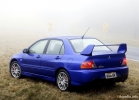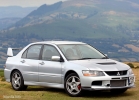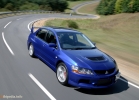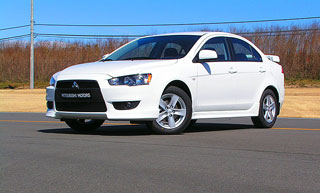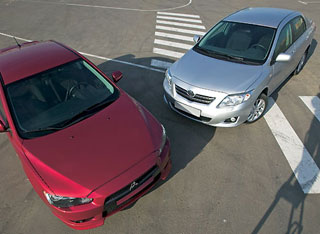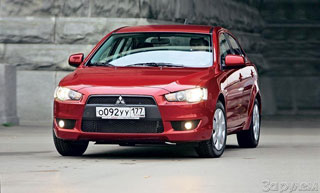Test drive Mitsubishi Lancer Evolution IX 2005 - 2007 sedan
Review Mitsubishi Lancer Evolution X GSR
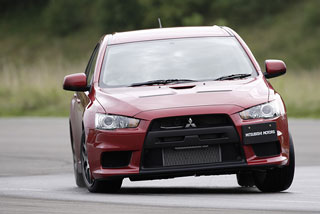 Well, we didn’t have time to talk about the new Mitsubishi car Galant Fortis, and in the Lancer family a new replenishment of the brilliant model Lancer Evolution X GSR. Our correspondent has his own report with Hokkaido from the town of Tokachi.
Well, we didn’t have time to talk about the new Mitsubishi car Galant Fortis, and in the Lancer family a new replenishment of the brilliant model Lancer Evolution X GSR. Our correspondent has his own report with Hokkaido from the town of Tokachi. The main parameters of the 10th generation Lancer Evolution
In order to be among the first to drive the new Mitsubishi Lancer Evolution X car, I had to go to Hokkaido to the Mitsubishi research center. It was there that at their test training ground, the developers decided to show representatives of the press their new brainchild.
Starting the movement, I first caught myself thinking that I felt at the wheel very calmly and confidently. And where to get anxiety, if the car, no matter what maneuver performed, did everything smoothly and measuredly. A particularly positive impression in this regard was made on me by the work of the chassis, that is, wheels and pendants. In the course of the case, I have repeatedly had to overcome steep turns, and to do this at high speed, when the back suspension turned out to be completely compressed. However, I did not feel the usual shocks in such cases, as if they were all absorbed by some kind of viscous environment. Moreover, this feature was manifested regardless of the category of the machine. Yes, I thought, since the first Lanevo car appeared, and this happened in 1992, much has changed in it for the better. At least, this is where the change of generations really is not just a formality, it is really a form of movement from good to better. And now the 10th generation, which can rightfully be called the English phrase High Performance, or, if translated, then a car made at a high technical level.
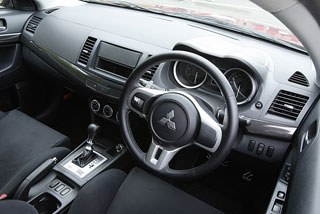 In fact, even according to external data, the car of the next, 10th in a row of generation not only reproduces the model of the previous one. No, it has become more and harder. And most importantly, she, so to speak, obviously matured in the sense that she began to behave more restrained on the go. Well, this, of course, is my emotional assessment, although it has a completely physical explanation. The car became as much as 100 kg heavier, that’s the matter.
In fact, even according to external data, the car of the next, 10th in a row of generation not only reproduces the model of the previous one. No, it has become more and harder. And most importantly, she, so to speak, obviously matured in the sense that she began to behave more restrained on the go. Well, this, of course, is my emotional assessment, although it has a completely physical explanation. The car became as much as 100 kg heavier, that’s the matter. Well, what else in it is so special, except for the mentioned 100 kg of excess weight. Let's watch.
Engine: The Cast iron block of the 4G63 series cylinders finally went into the past, and the aluminum engine of the new development 4B11 took in its place. Naturally, it is still equipped with a turbine.
The Torque Control 4WD Torque Control 4wd control system has become more precise.
A double clutch model appeared in the row, which is armed with a 6-speed two-pedal mechanical gearbox.
And now another, maybe even the most important feature: as before, the manufacturer tries with all his might (I don’t know how they succeed!) So that the car does not become too expensive to customers. Look: the most massive GSR model, if it is with 5-speed mechanics, costs 3,495,045 yen ($ 31,264). If the same machine is equipped with a 2-speed 6-speed transmission with two clutch (TC-SST), then 3,750,600 yen ($ 33,550) are asked for it. And finally, the racing version of the RS 2 997 750 yen ($ 26 815).
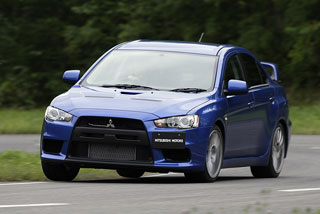 Earlier information was held that the new Lanevo X will appear on sale from October 1, 2007, however, as it became known, this is not all the truth. The fact is that the model on which the manufacturer makes the main bet will appear on the market with a delay: its debut is scheduled for the last decade of November.
Earlier information was held that the new Lanevo X will appear on sale from October 1, 2007, however, as it became known, this is not all the truth. The fact is that the model on which the manufacturer makes the main bet will appear on the market with a delay: its debut is scheduled for the last decade of November. Smooth switching this is the essence of SST
To make it easier for guests to go on the course of business, all the new generation Lancer Evolution cars were built in even rows for inspection. But we, the guests, were also not a missing guys: everyone went and went from one car to another, delay with their choice. At that moment, I remember, I thought: yes, only fans of Subaru cars were famous for such a focused, and now, apparently, they decided to show exactly the same moodiness in relation to Lanevo cars. And I am also no exception!. Imagine: here I look at the car behind, and I myself think: Ah, copied from the Alfa Romeo car, you won’t even get out. Here's the annoyance!. And most importantly: the ass is, maybe, it looks like this, allegedly, you are supposedly immediately forget when you go in front and see a wide open pharynx (meaning a radiator grille), which is associated with such traits of a car nature as aggressiveness and assertiveness .
I want to note that some time ago, the Volkswagen concern developed and began to use a transmission type DSG. So, in the Lanevo X car, we, in fact, are dealing with a variety of this transmission,, so to speak, the interpretation made by Mitsubishi. By the way, this is not an individual development, this is the result of the joint efforts of Mitsubishi and Getrak. The essence of this device is that in fact, two clutches of each other are in the machine, closely interconnected. Thanks to this, such smoothness of manual switching is achieved that any machine with a hydrotransformer could envy it.
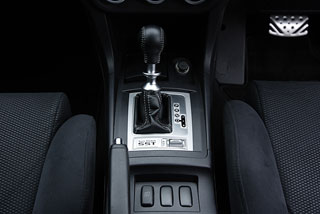 I don’t know how this device will prove itself in driving along ordinary city or suburban routes, but as for the testing landing ground, then, of course, you just have a little use, accept the conditions of the game, and then everything goes, as in clockwork. And the higher the speed, the more the clutch slips. Sometimes it even resembled a crawling movement mode at an automatic transmission. And even when I had to move up the mountain (and this is an obligatory point of the test exchange rate), it never happened that I remove my leg from the brake pedal, and the car would go back. Never! So those of the future owners of Lanevo X who are used to driving on the machine, the transition to two -pedal mechanics will not be difficult.
I don’t know how this device will prove itself in driving along ordinary city or suburban routes, but as for the testing landing ground, then, of course, you just have a little use, accept the conditions of the game, and then everything goes, as in clockwork. And the higher the speed, the more the clutch slips. Sometimes it even resembled a crawling movement mode at an automatic transmission. And even when I had to move up the mountain (and this is an obligatory point of the test exchange rate), it never happened that I remove my leg from the brake pedal, and the car would go back. Never! So those of the future owners of Lanevo X who are used to driving on the machine, the transition to two -pedal mechanics will not be difficult. In the SST transmission, in addition to the usual mode (designated as Normal), there is a Sport mode, as well as Super Sport. If we talk about the Super Sport mode, then it is intended for those who, sitting behind the wheel, are used to driving for a while. In other words, the switching program is designed for the case when the tachometer arrow does not fall below 5,000 rpm. You know, in fact, I was somehow not in the mood that day, but as soon as I heard the engine roar of the engine instantly turning into a high tonality, and I seemed to be replaced: blood ran faster, and lethargy did not happen!
What is Super Sport, you should get out of the normal mode and switch to Sport mode, like everyone else, the switch lever immediately begins to operate according to a completely different program, more aggressive, or something. Be that as it may, for an ordinary, average driver who loves to travel in an active manner, Sport mode is just what you need. As for Super Sport, it is like an expensive sword that you can not even take out, but just look at it, and this contemplation is already enjoying.
Ah yes driver, what a well done!
If we talk about a car with an ordinary 5-speed manual box, I immediately note: the clutch pedal here is quite elastic, pressed with some effort. Well, I thought, as soon as my leg felt resistance, no matter how high the car was different, and it is still more pleasant to put pressure on the clutch pedal!. And then he scolded himself as a joke: what kind of retrograde are you like that, you all want it to be in the old fashioned way!.
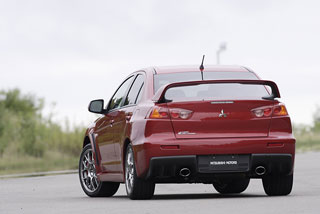 However, jokes aside, especially if you have such a powerful engine under the hood. So, get acquainted: 4b11 motor, develops a power of 280 hp. At a rotation frequency of 6,500 rpm, and a torque of 43.0 kg-m (the peak occurs at 3,500 rpm). It is interesting that this was completed by a new development, but it was decided to adjust it according to the model and likeness of the engine of the former model. As a result, the peak of power occurs at the same revolutions as before, moreover, the power itself remained unchanged. As for the torque, it has become more, and its maximum comes at lower speeds than before. The turbo engine, which is designed for Lanevo, and the unit that is used on the Mitsubishi Outlander model is two more difference. And the point is not only that in the second case the intake is atmospheric, but in the first turbo. No, they have a lot of other differences, and, above all, different cylinder blocks. The Lanevo motor is more powerful, so it was necessary to strengthen all the main nodes. And the cooling system also had to be redone. So I had to take pistons from Mare, put a flat extensor of coolant, shorten the intake manifold, and so on. And all this is in the situation, when the principle is proclaimed: no unnecessary expenses, everything should meet the pre -established estimate so as not to bend the sale price. Moreover, in the future, this motor, apparently, will appear on other Mitsubishi machines, however, with other settings.
However, jokes aside, especially if you have such a powerful engine under the hood. So, get acquainted: 4b11 motor, develops a power of 280 hp. At a rotation frequency of 6,500 rpm, and a torque of 43.0 kg-m (the peak occurs at 3,500 rpm). It is interesting that this was completed by a new development, but it was decided to adjust it according to the model and likeness of the engine of the former model. As a result, the peak of power occurs at the same revolutions as before, moreover, the power itself remained unchanged. As for the torque, it has become more, and its maximum comes at lower speeds than before. The turbo engine, which is designed for Lanevo, and the unit that is used on the Mitsubishi Outlander model is two more difference. And the point is not only that in the second case the intake is atmospheric, but in the first turbo. No, they have a lot of other differences, and, above all, different cylinder blocks. The Lanevo motor is more powerful, so it was necessary to strengthen all the main nodes. And the cooling system also had to be redone. So I had to take pistons from Mare, put a flat extensor of coolant, shorten the intake manifold, and so on. And all this is in the situation, when the principle is proclaimed: no unnecessary expenses, everything should meet the pre -established estimate so as not to bend the sale price. Moreover, in the future, this motor, apparently, will appear on other Mitsubishi machines, however, with other settings. It is easy to guess that since the engine is turbocharged, a powerful torque makes itself felt at low speeds. So it happened. On the other hand, the engine reaction to control commands should also be evaluated well.
The pride of Mitsubishi engineers is, of course, the S-AWC (Super All Wheel Control) control system, which is constantly being improved. So the new generation Lanevo in this regard was no exception. I can say that at the moment, in this particular car, it acts so prudently that I, the driver who has not been too longing in sports driving, determine when it acts, and when it is inactive, it is almost impossible. It turned out like this: when I was moving at high speed, and I needed to turn a little, it turned out just great. If so, I thought, then cool turns and I probably will succeed no worse. Well, if not at too high speed, then on average it is for sure!. I did not feel that it was not me, it was the S-AWC system that helps me like that. Moreover, my memories of the test of the new Honda Legend car are still fresh. There really every time you enter a steep turn, you immediately determine: oh, it seems, the insurance system has earned. And while driving Lanevo X everything is completely different. Therefore, I, of course, considered all the successful antics of the car to be mine. No, I understood that the level of my skill is not the same, but the main thing is how you feel, and not what is actually happening. So I, leading the car on a rather difficult test track, did not stop repeating: oh, well done, how dashing you did it! And sincerely rejoiced for himself.
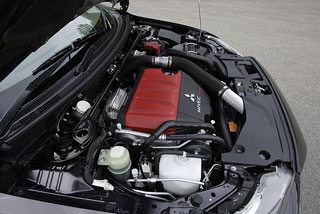 Further evolution of Lancer Evolution
Further evolution of Lancer Evolution The S-AWC control system combines several subsystems: the control system for the distribution of the torque between the rear and front pair of wheels (ACD), the redistribution system of the rotational moment between the left and right wheel (AYC), the system of individual control of the brakes on all wheels (ASC) and anti-locks System (ABS).
Previously, in the Lanevo IX car, sensors of the angle of rotation of the steering wheel, speed of movement and lateral departure of the front and back of the machine operated. Based on the signals received, the system itself decided that the machine could be done, but how to behave. In a new generation Lanevo, everything has become even more complicated: the speed of rotation of the machine around the vertical axis, the torque of the engine (rotation speed of the crankshaft) and brake pressure are taken into account. The goal is simple and understandable: to load as much information as possible into the processor of the management system so that its solutions become more reasonable.
So, everything is already so predetermined that the driver only remains to repare himself to the car, as a kind of higher power, so what? No, the developers of the S-AWC control system answer, in no case. On the contrary, we tried to ensure that even a beginner, sitting behind the wheel of a Lanevo car, felt the pleasure of driving a car, and not from communicating with an electronic control intermediary. Well, it’s good if so.
By the way, how many remember when active export abroad the Lancer Evolution family began? I remind you: this happened with the start of the production of 8th generation machines in 2003. Yes, indeed, then they spoke about them both in America and in Europe, and these conversations do not subside there to this day. Moreover, it is predicted that the 10th generation in North America will be sold twice as much as in Japan itself.
Over time, the body is being done more and more. The combination of a super-powerful engine + 5-speed manual box can also be very in demand. However, for some reason, all this is not enough, and the developers decide to enter another car with two-pedal mechanical transmission into the model range. Yes, I see, many people think that the more the car can and the higher its level, so to speak, technical training, the better. And the inevitable increase in weight can be compensated for even more power, so what? But if so, then soon the Lanevo machine will become a real monster.
Of course, the authority of Mitsubishi Lancer Evolution as a participant in the WRC (world rally championship) is not the same. At the same time, I would really not want this car instead of the status of a combat vehicle to participate in the rally to become more and more as much as a premium car with all the ensuing changes in pricing policy. However, I hope that this will not happen, and that along with the trend of High Performance (demonstration of a high technical level) there will be a tendency of High Cost Performance, that is, the desire to maximize the cost of the machine manufactured. This was observed before, I really want to believe that, in spite of everything, it will continue to continue.
Technical characteristics of the Mitsubishi Lancer Evolution GSR car
Full length: 4 495 mm.
Full width: 1 810 mm.
Complete height: 1,480 mm.
Wheel base: 2 650 mm.
Machine weight: 1,520 kg.
Drive: 4wd.
Engine: 2-liter with turbocharged, 4-cylinder with a vertical-row cylinder arrangement, DOHC gas distribution mechanism with 16 valves, developed power of 280 hp. at 6,500 rpm, maximum torque 43.0 kg-m at 3,500 rpm.
The basic price of the car: 3 495 045 yen ($ 31 264).
The price of the tested machine (in the High Performance configuration): 3 915 045 yen ($ 35 021). The difference in price was formed due to BBS aluminum discs.
Source: Webcg.net



